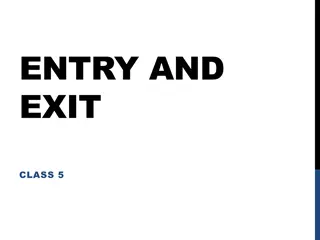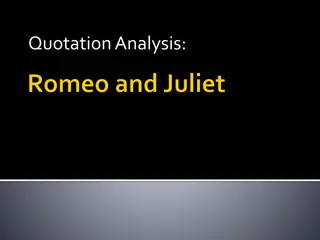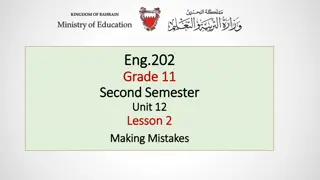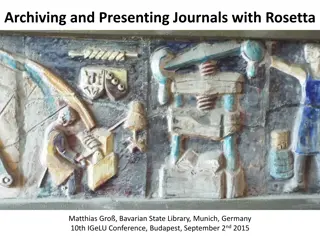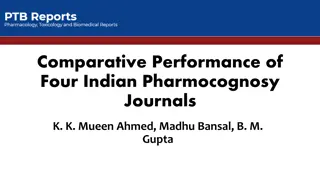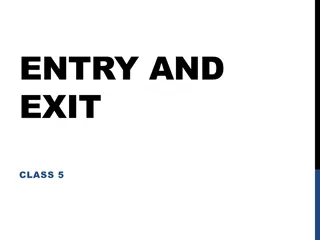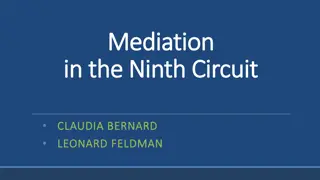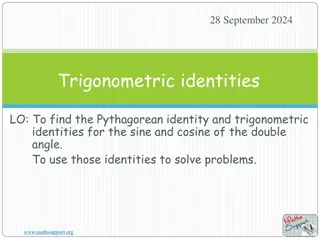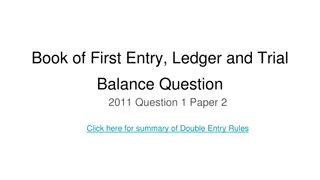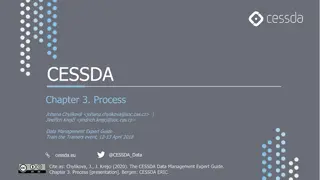Common Mistakes in Literary Double-Entry Journals
Diction analysis in double-entry journals often involves discussing the author's word choice and its impact on the overall meaning. Examples from various literary works, such as Bradbury's "Fahrenheit 451," demonstrate how specific words contribute to characterization and thematic development. Understanding diction helps readers delve deeper into the subtleties of a writer's craft.
Download Presentation

Please find below an Image/Link to download the presentation.
The content on the website is provided AS IS for your information and personal use only. It may not be sold, licensed, or shared on other websites without obtaining consent from the author. Download presentation by click this link. If you encounter any issues during the download, it is possible that the publisher has removed the file from their server.
E N D
Presentation Transcript
Literary Terms Common Mistakes in the Double-Entry Journals
Diction Incorrect: The author uses diction. Incorrect: The author uses good diction. Diction is the author s word choice. In order to analyze diction, you must discuss specific words you think were carefully chosen. Strong analysis will discuss the Task/Purpose of the words that were selected. Why did the author select the word? How does it contribute to the overall meaning?
Diction This helps to improve diction, organize what they want to say and focus on the main points of interest. Poetic diction describes the range of language used in poems. The decision to use an archaic diction might thus be thought a central part of spenser's particularly protestant poetics. The decision to use an archaic diction might thus be thought a central part of spenser's particularly protestant poetics. The choir had very good diction, which enabled the audience to hear nancy bush's words clearly. Clear diction, not a ' posh voice ' , was what was wanted. Diction employed by the author seems to exaggerate and stretch the truth. His perfect diction never failed to be commented on. Diction found in the sestet, could be used throughout, imvho. Bridget's excellent diction was just loud enough to create an ambient echo which rather suited her careful english tones.
Diction Like Harlequin rats (Bradbury 89). The word harlequin is rarely used any more, and I was a little shocked to to see it. I remember when I was in elementary school, my group of friends started using this word. Why did the author use the word harlequin?
Diction The flutter of cards, motion of hands, of eyelids, the drone of the time-voice in the firehouse ceiling (Bradbury 32). The word drone sounds very robotic. It s almost as if Montag is discovering how robotic his world is and how he used to be. Clarisse has caused this self realization.
Diction Montag saw the flirt of a great metal fist over the far city, and he knew the scream of the jets that would follow, would say, after the deed, disintegrate, leave no stone on another, perish. Die (Bradbury 158). Instead of using words such as passed away, Bradbury uses harsher words such as disintegrate and perish to illustrate the anger Montag is feeling.
Symbol Incorrect: The situation is symbolic Symbol objects used to represent other things and ideas You must identify an actual object discussed in the passage, but you must also discuss the abstract idea it represents.
Symbol Beatty never drove, but he was driving tonight, slamming the Salamander around corners, leaning forward high on the driver s throne (Bradbury 109). The Salamander is referring to the fire truck and means more than it seems. What does the Salamander symbolize?
Symbol The queen in her silken cocoon had no words to give back; but when he closed his eyes and tried to remember, instead of a memory came new images (Card 320). What does the bugger queen cocoon symbolize in the novel?
Symbol Janie saw her life like a great tree in leaf with the things suffered, things enjoyed, things done and undone. Dawn and doom was in the branches (Hurston 8). The author uses the symbol of the pear tree to represent Janie s life. She has suffered pain and loss, enjoyed love and marriage, and has learned from her mistakes.
Symbol Waves were reaching up, and their white foam caught by the wind, was being whipped against the side of the ship. But I d seen that on other days and the ship hadn t sunk. A cargo ship is a huge and stable structure (Martel 127-128). The ship symbolizes stability and comfort, a regular life. The sea is the opposite; it screams, unknown. It is wild, unpredictable, and dangerous.
Figurative Language Incorrect: The author uses figurative language to create a picture in the reader s head. Literal language words are used as their denotation (dictionary definition) would suggest. Figurative language words are used for their connotation (layers of meaning) and alter or exaggerate the usual meaning of the word. The ground is thirsty ground is literal, but thirsty is figurative. The author is actually talking about the ground but the author means the ground is dry. Similes, Metaphors, Personification, Hyperbole, Figures of Speech, Allusions, Paradox, Oxymoron, are all considered figurative language.
Figurative Language But then usually a new commander has had a few defeats under his belt before he first makes it in here. I only got in here a month ago. If anybody deserves a cheer, it is you. That s life, make them eat dust (Card 184). The phrases defeats under his belt and make them eat dust are figures of speech. What effect do they have on the passage?
Figurative Language To survive with a tiger was like trying to survive twenty-seven gunshots, impossible (Martel 155). The figurative language is the twenty-seven gunshots. Martel is using the simile to compare his chances of surviving Richard Parker to surviving a gunshot.
Figurative Language The good writers touch life often. The mediocre ones run a quick hand over her. The bad ones rape her and leave her for the flies (Bradbury 83). The verbs used, touch, run, rape, are figurative expressions. Perhaps, Bradbury is suggesting that good writers have many meaningful life experiences, mediocre writers have some experiences, and bad writers fail to interpret meaning from their life experiences.
Figurative Language Then she starched and ironed her face, forming it into what people wanted to see (Hurston 87). The author says Janie starched and ironed her face, but she didn t really do that. It compares her ironing her face to having to get ready to be someone she is not. She was just showing them what they wanted to see.
Imagery & Allusion Most students can identify imagery or allusion; however, most students fail to discuss the Task/Purpose of the literary technique. Why did the author use imagery? How does is contribute to the overall meaning of the passage? Why did the author choose to include an allusion? How does it enhance the meaning of the passage?
Tone vs. Mood TONE and MOOD are two different concepts in literature. TONE describes the author s attitude toward his/her subject. The attitude may be stated in so many words or implied. Diction is a key to tone. MOOD is the situation's atmosphere or characters' feelings:
Tone aloof affectionate aggravated amused angry apathetic calm appreciative celebratory approving condescending arrogant contemplative bitter critical cynical despondent disinterested emphatic formal intense light-hearted nonchalant pessimistic romantic sincere sympathetic dark didactic distant encouraging happy ironic melancholy optimistic plaintive sad somber uninterested dejected disappointed droll enthusiastic haughty joyful melodramatic paranoid playful sarcastic soothing whimsical depressed disapproving earnest excited hurt lackadaisical nervous passive pleading scornful superficial wistful desperate disgusted ecstatic facetious informal languid neutral patronizing proud serious suspicious wry
Mood MOOD is the situation's atmosphere or characters' feelings: Calm Cheerful Chilling Comical Dark Depressing Dismal Eerie Fanciful Foreboding Gloomy Grim Grotesque Heart-breaking Heartrending Holy Light Hopeful Lighthearted Horrific Melancholic Intense Morbid Joyful Mournful Mysterious Ominous Optimistic Pessimistic Powerful Romantic Sad Sinister Soothing Sorrowful Spiritual Spooky Terrifying Threatening Tranquil Whimsical
Tone/Mood The biggest mistake students make is not using appropriate words to describe Tone and Mood. Once you identify an accurate word to describe the tone/mood, you must discuss the choices the author made to establish this tone/mood. What effect does it have on the passage and overall meaning?
Tone (authors attitude) OR Mood (atmosphere or character s feelings)? affectionate sorrowful desperate dark eerie morbid grim enthusiastic optimistic mysterious joyful calm hopeful threatening romantic sarcastic suspicious soothing
Tone OR Mood? affectionate sorrowful desperate dark eerie morbid grim enthusiastic optimistic mysterious joyful calm hopeful threatening romantic sarcastic suspicious soothing
Theme Remember Big Ideas are topics for theme, but they are not thematic statements. When discussing theme, you should always be making a comment about what the author was revealing about life or the human condition. Survival = Big Idea Never give up = Clich Survival requires mental stamina, prudence, and perseverance = Thematic Statement






